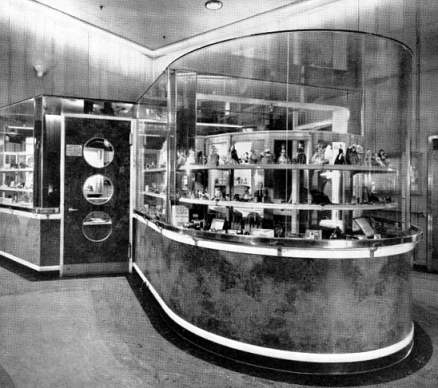The Interiors of RMS Queen Elizabeth (1938)
Introduction
On 16 June 1946, the Queen Elizabeth was put into dry dock at Southampton to complete her refurbishment. Large amounts of furniture were fitted into the liner.
There were 4500 settees, chairs and tables, 4000 mattresses, 50,000 items of bed and table linen, 31,000 pillow cases, 21,000 towels, 6000 curtains which represented three miles of material, six miles or 2000 carpets and rugs (six miles to be cleaned everyday) and 1500 wardrobes and dressing tables included amongst restored items. She served 10,000 meals a day. She needed over half a million pieces of china.
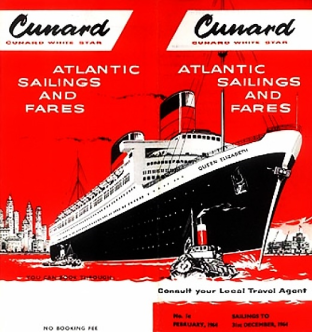
Some of the staple foods carried on one round voyage of the Queen Elizabeth included 70,000 pounds of meat, 25,000 pounds of poultry, six tons of fish, 30 tons of potatoes, 30,000 pounds of fresh vegetables, 10,000 pounds of frozen vegetables, 300 barrels of flour, six tons of sugar, 1,000 crates of fresh fruit, 5,000 quarts of milk, two tons of butter and over 4,000 quarts of ice cream.
The Queen Elizabeth offered three acres of deck space for recreation equal to the ground area within the Yale Bowl at New Haven.
The forward funnel of Queen Elizabeth was 70 feet in height with an elliptical cross section of 44 feet by 30 feet. The size of them was big enough to allow three new locomotives to pass through them. She had two funnels, three anchors, and a greater rake to her bow.
She had a flush main deck which was 11 feet longer than the Queen Mary. Special high elastic steel plates were used in the construction of the Queen Elizabeth to absorb the stress to which she would be subjected to because of her size. The steel plates in the hull range from 8 to 30 feet in length. Expansion joints were built in the superstructure to relive stress.
The letters Q U E E N E L I Z A B E T H on the bow of the ship were 2.5 feet high and extended nearly 68 feet.
The Queen Elizabeth was steered by a gyro compass. There were three radar units one with a range of fifty miles, another with ten mile range and another for aircraft detection. The main engines of the ship generated about 200,000 horsepower equal to about 50 locomotives (in 1945).
There were 30,000 lights and more than 4000 miles of wiring in the Queen Elizabeth. Four turbo generators delivered 10,000 kilowatts per hour, providing sufficient energy to meet the lighting and public service needs of a city of 150,000 people.
There were extensive public address systems on board relaying incoming radio broadcasts and announcements. Passengers could call any part of the world by merely picking up a bedside telephone. Ship-to-shore telephone calls were “scrambled” by secrecy devises so that the conversation could not be intercepted by unauthorized persons either on board ship or ashore.
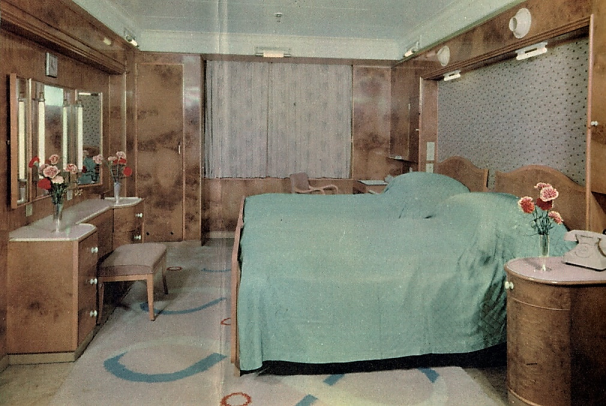
The Queen Elizabeth had 35 public rooms, including a First Class Restaurant with an area of 13,133 square foot and a theatre seating 338 people. Turkish and curative baths also offered ultra-ray infrared ray and diathermy treatments.
She was fully equipped with a general hospital and operating theatre. There are more than fifty kinds of rare and unusual woods used in the Queen Elizabeth, including petula, patapsko pomla, avodire, tiger oak, makore, bubinga, zebrano and blackbean.
The Main Entrance Hall was forward of the Main Lounge. The room spanned the entire width of the ship. A Bronze statue of a female figure swimming through the arms of her male companion surrounded by dolphins stood in the Main Entrance Hall. It was inspired by Jean Sibelius’s Tone poem “The Oceanides” 0p. 73 and sculptured by Maurice Lambert.
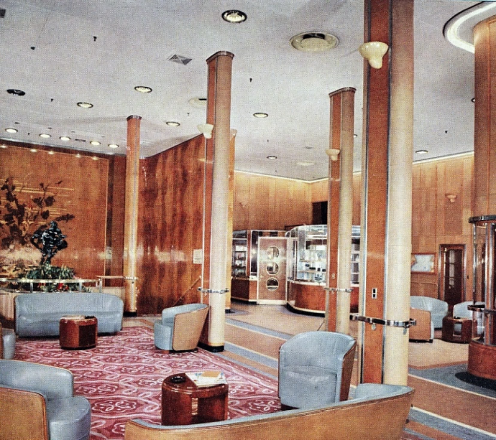
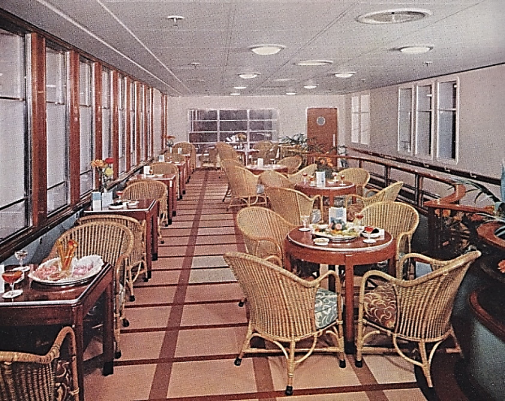
George Grey Wornum was in charge of the vessel’s interior decoration. The Main Lounge (pictured below), on the Promenade Deck was panelled with a tawny pink Canadian maple burr veneer. The world was put into relief by the panels covered in leather of light grey, pale blue and buff. On one wall was a portrait of Her Majesty the Queen.
Two paintings called “Elsinore” and “Dover Harbour” hung in the Main Lounge: their artist, Norman Wilkinson had also been responsible for the paintings on board the Titanic (Plymouth Harbour) and the Olympic (Approach to the New World).
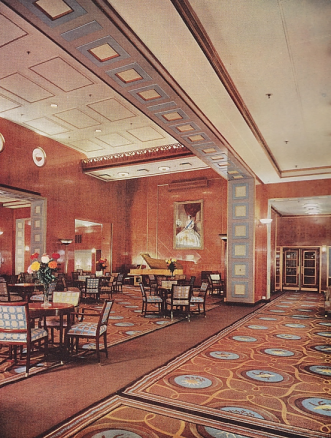
Aft of this room was a writing room, the alcoves of which were also lined with leather.
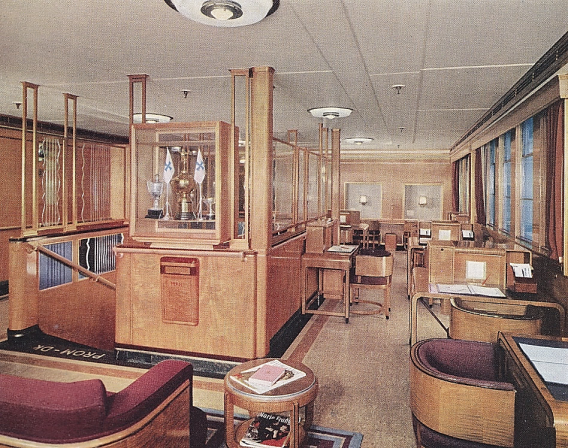
Restaurants of the three classes were placed on the same deck (Restaurant Deck); their respective kitchens separated them.
The First Class Restaurant’s entrance hung the Royal cipher carved in line by Bainbridge Copnall. The room was 110 feet long by 115 feet wide and was panelled in Myrtle cluster.
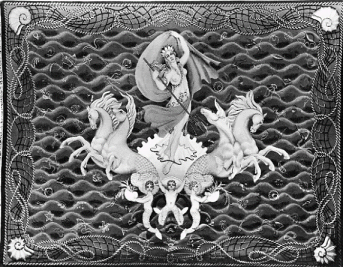
On the wall at the back of the First Class Restaurant, you can see the needlework tapestry designed by Miss E. Esmonde-White.
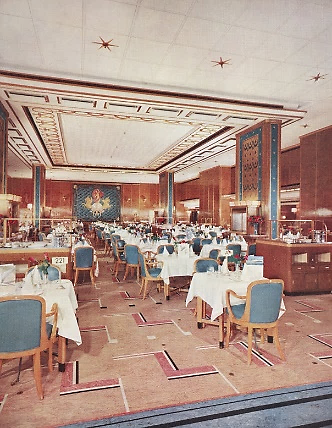
The Veranda Grill had its own kitchen and it probably was the most exclusive room on board. The grill was decorated in ivory to compliment the peach coloured velvet curtains. It proved a great attraction because of its daytime sea views. Eating in the grill was exclusive and cost extra.
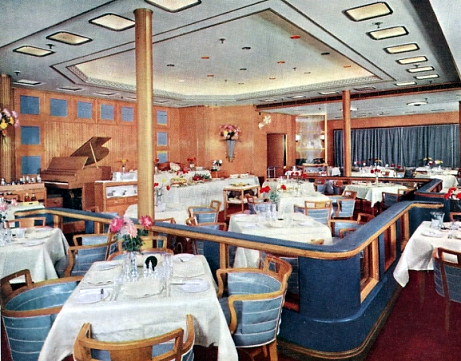
The Smoking Room was described as “…magnificent with its atmosphere of quiet dignity.” The four veneers were cut from one walnut tree from the Isle of Wight. There was a triple electric fireplace in the Smoking Room.
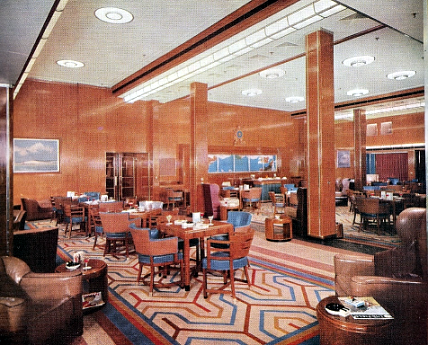
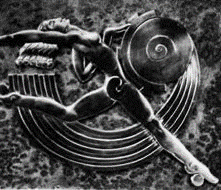 Above the fireplace was a series of nine bas-reliefs placed on the veneered panel. They were individually carved or cast from the materials used in the construction of the ship.
Above the fireplace was a series of nine bas-reliefs placed on the veneered panel. They were individually carved or cast from the materials used in the construction of the ship.
The sculptor Dennis Dunlop was commissioned to carve scene of hunting, shooting and fishing together with a clock.
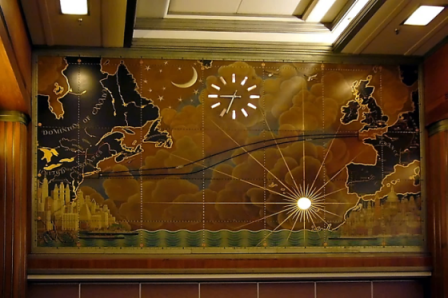
Macdonald Gill was commissioned to create a moving model map of the two Queens showing passengers where they were in relation to each other.
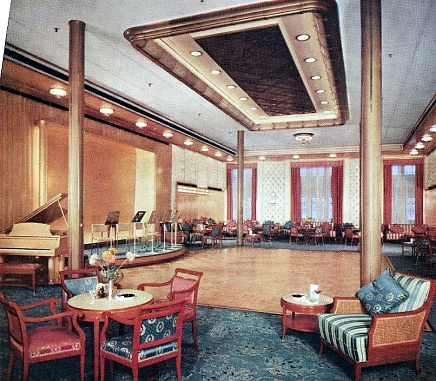
The First Class Salon Situated on the promenade deck, its ceiling was gilded and walls draped in quilted satin. There was a stage for musicians and entertainers and was a great setting for dancing. Opposite the stage was a deep recess which contained a stained glass depiction of a lively jungle scene of tropical birds, antelopes and monkeys designed by Jan Juta.
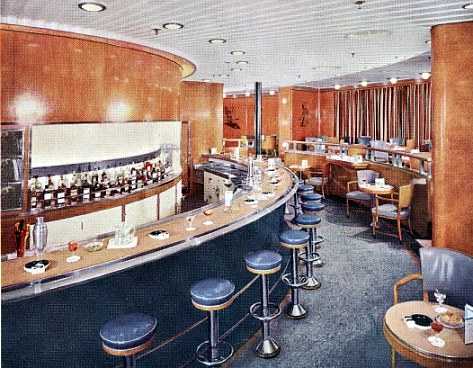
The First Class Observation Lounge and Cocktail Bar enjoyed forward views over the bow to the horizon. Perhaps in storms, the sea may have come over the bow? The room was panelled in lobster red sycamore.
As with her predecessors, the Queen Elizabeth provided a gymnasium for Cabin Class.
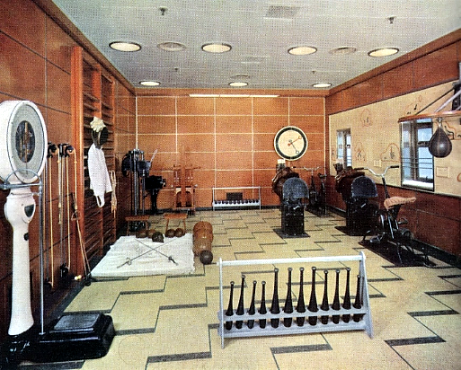
The Theatre could hold an audience up to 338 people. With a blue carpet, ivory white walls, it was a very pleasant and comfortable experience to be able to watch a film or other entertainment and was open to both Tourist and Cabin Class.
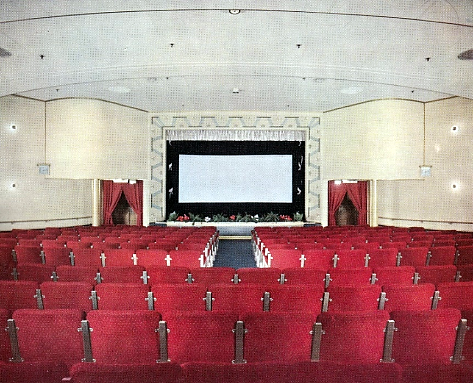
A swimming pool was provided for use by the First and Second Class passengers.
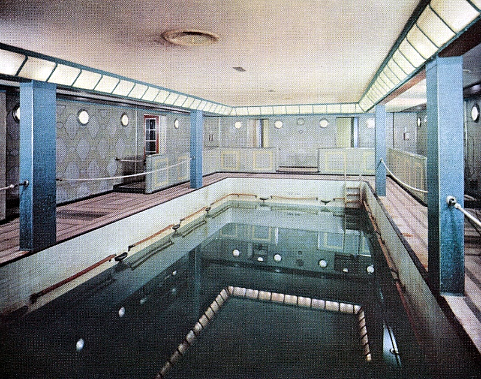
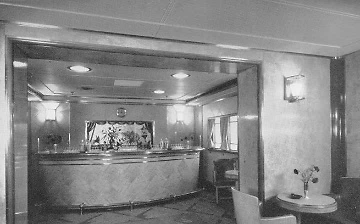
The Third Class were provided with a library containing 4000 books.
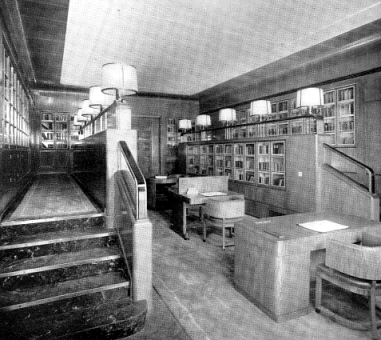
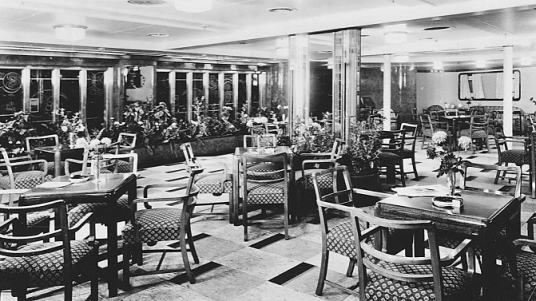
There was a shop on board selling mementos and souvenirs from Cunard.
